英语:Unit3《Understanding each other》课件(译林牛津版选修6)
文档属性
| 名称 | 英语:Unit3《Understanding each other》课件(译林牛津版选修6) |  | |
| 格式 | zip | ||
| 文件大小 | 1.1MB | ||
| 资源类型 | 教案 | ||
| 版本资源 | 牛津译林版 | ||
| 科目 | 英语 | ||
| 更新时间 | 2012-04-10 20:10:27 | ||
图片预览

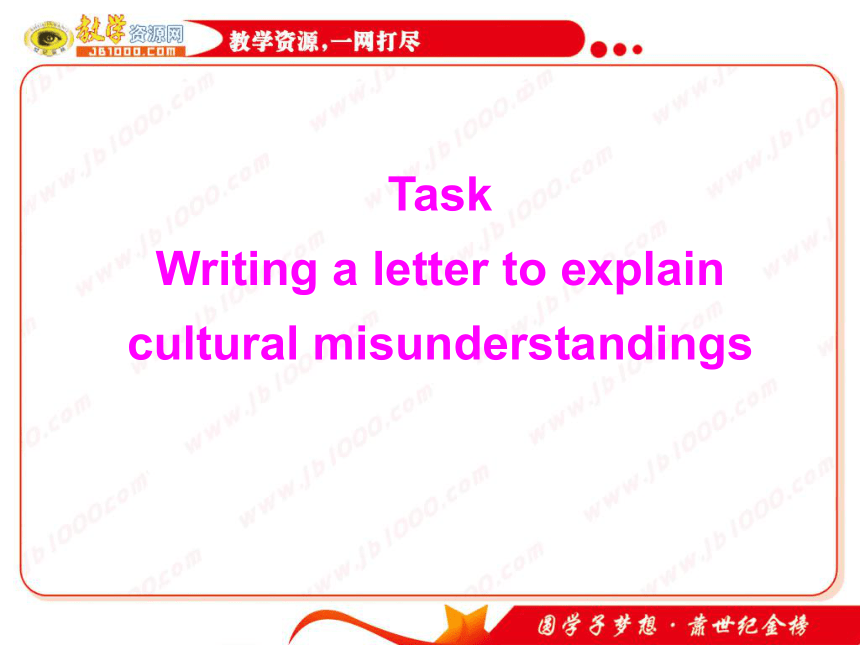
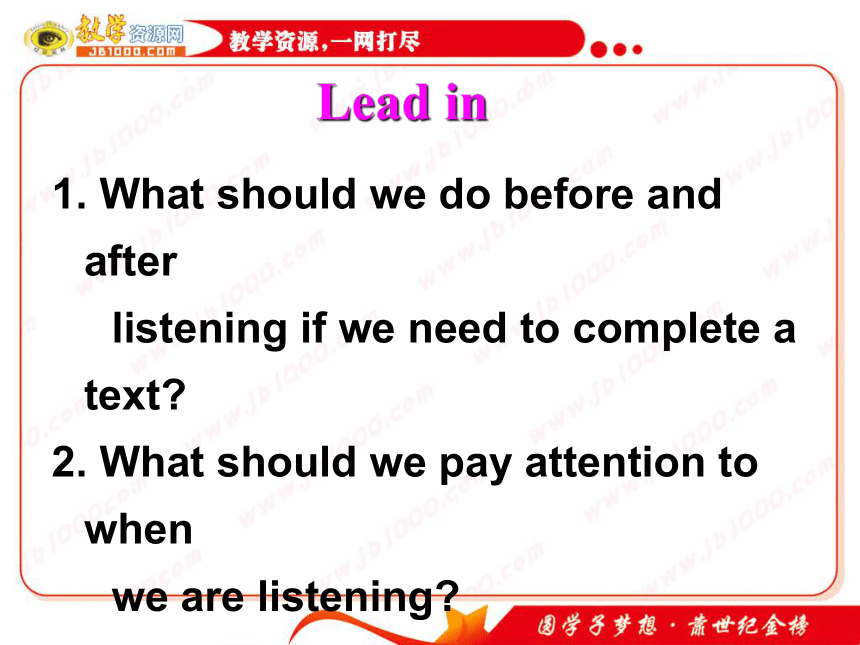
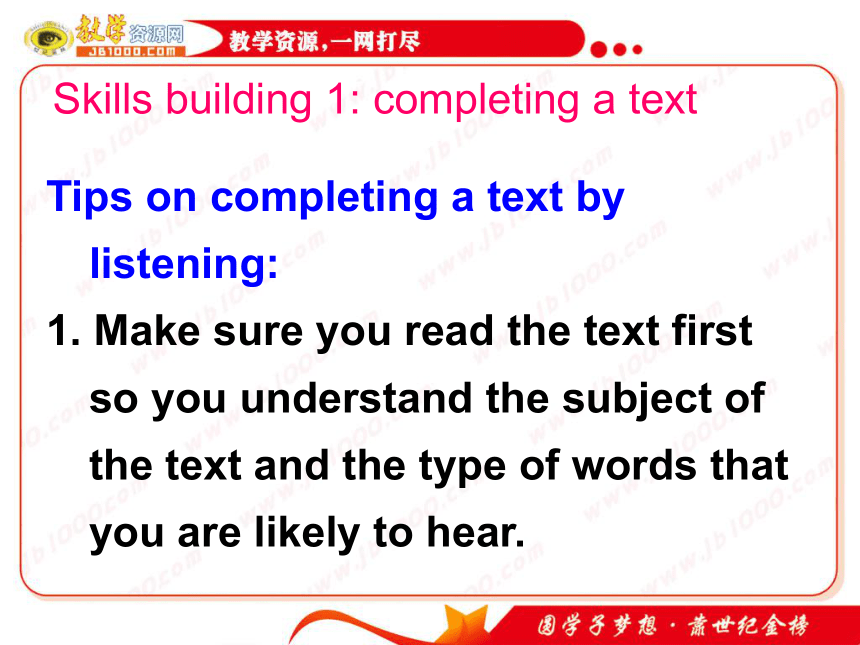
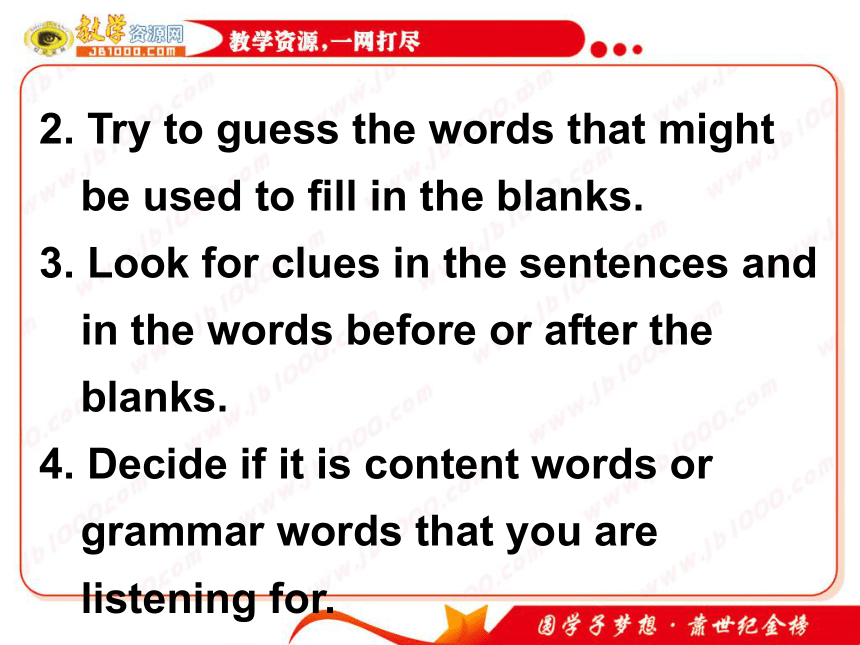
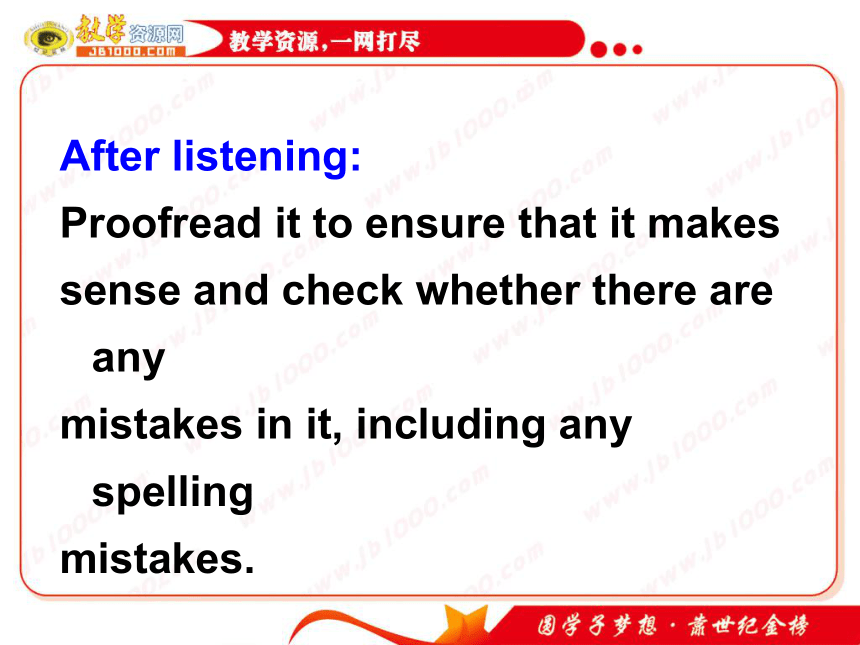

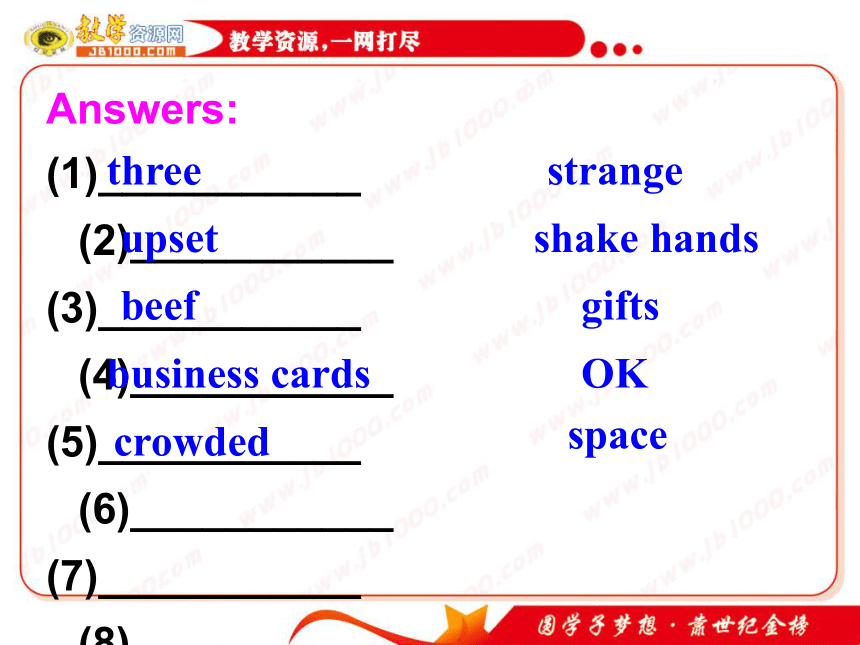

文档简介
(共28张PPT)
牛津版
高二 模块六Unit 3
Task
Writing a letter to explain cultural misunderstandings
Lead in
1. What should we do before and after
listening if we need to complete a text
2. What should we pay attention to when
we are listening
Skills building 1: completing a text
Tips on completing a text by listening:
1. Make sure you read the text first so you understand the subject of the text and the type of words that you are likely to hear.
2. Try to guess the words that might be used to fill in the blanks.
3. Look for clues in the sentences and in the words before or after the blanks.
4. Decide if it is content words or grammar words that you are listening for.
After listening:
Proofread it to ensure that it makes
sense and check whether there are any
mistakes in it, including any spelling
mistakes.
Listen to the conversation and complete the diary. Remember the tips on completing a text by listening.
Step 1: Showing foreign visitors around
Answers:
(1)___________ (2)___________
(3)___________ (4)___________
(5)___________ (6)___________
(7)___________ (8)___________
(9)___________ (10)__________
three
strange
upset
shake hands
beef
gifts
business cards
OK
crowded
space
Read part B on page 43, and circle the taboos that help explain some of the strange incidents mentioned in the diary.
If you are from India, you may not eat beef because of your religion.
If you are from the West, you probably would not like to eat chickens’ feet, but it’s not a taboo.
Suggested answers
In India, it is impolite to shake hands or give someone something with your left hand.
Japanese people get upset if people do not look at their business cards carefully. Remember not to just put the business cards in your pocket without looking in Japan .
Listen for more information about culture habits and fill in the blanks in your notes below.
Answers:
1._____________ 2.______________
3._____________ 4.______________
uncomfortable
gifts
the USA
small change
Skills building 2: asking questions
When we want to find out about something, we need to ask questions.
How many question words do you remember
What---when we want to find out about something specific, e.g. things/ people/ places
How---when we want to find out the way something should be done.
Which---when we want to specify which one of a choice of possibilities.
When--- when we want to inquire about
time
Why---when we want to find out a reason
Where---when we want to find out about
the place in which something
happened
Step 2: asking about culture differences
Work in pairs to ask questions about culture differences. You can answer the questions according to what we learned.
1. What food do the people from India not eat
2. Which hand shouldn’t be used to shake hands with or give things to people from India
Suggested answers
Some people from India don’t eat beef
because of the religion.
The left hand.
3. What do Japanese people have to buy when they travel anywhere
4. What should you do when a Japanese person gives you a business card
When they travel anywhere, Japanese
people have to buy many gifts.
We should look at the card carefully.
5. What does the OK sign mean for Japanese people
6. Why do people from the USA do not like crowded places
It means a request for some small change.
They feel uncomfortable if others are in
their ‘personal space’, which is about 50
centimeters around them.
Skill building 3:
writing a letter of apology
1. Do you know the differences between
writing letters in Chinese and writing
letters in English
2. What do you usually say if you want to
make an apology
Address of the sender
Date
Name and address
of the recipient
Greeting/ an opening
The body of a letter/ content
closing
name/signature
When writing a letter of apology, you need to include the following:
your address
the date
an opening
the purpose of the letter
an explanation
a closing phrase (to apologize again)
your name and signature
Step 3: explaining misunderstandings
Work in groups to discuss what to include
in your letter of apology. After discussion,
write your letter in the blanks on page 45.
Possible example
Mr. Singh
(Address)
Dear Mr. Singh,
I’m writing to apologize for any
misunderstandings that occurred when I
showed you around Beijing the other day.
I felt rather strange when you would not
shake hands with me. I did not realize that
there are some taboos in different countries
and cultures. After reading a magazine
article, I know that people from India don’t
shake hands with their left hands. I should
not have held out my left hand to you. And
I know you do not eat beef because of your
religion.
I feel very sorry for not having known
these taboos earlier. I hope you can forgive me for all these misunderstandings. I hope
our next meeting will be happier.
Yours sincerely,
***(name)
Homework
Finish your letter of apology. You can write
a letter to Mr. Takashi or Mr. Hudson.
牛津版
高二 模块六Unit 3
Task
Writing a letter to explain cultural misunderstandings
Lead in
1. What should we do before and after
listening if we need to complete a text
2. What should we pay attention to when
we are listening
Skills building 1: completing a text
Tips on completing a text by listening:
1. Make sure you read the text first so you understand the subject of the text and the type of words that you are likely to hear.
2. Try to guess the words that might be used to fill in the blanks.
3. Look for clues in the sentences and in the words before or after the blanks.
4. Decide if it is content words or grammar words that you are listening for.
After listening:
Proofread it to ensure that it makes
sense and check whether there are any
mistakes in it, including any spelling
mistakes.
Listen to the conversation and complete the diary. Remember the tips on completing a text by listening.
Step 1: Showing foreign visitors around
Answers:
(1)___________ (2)___________
(3)___________ (4)___________
(5)___________ (6)___________
(7)___________ (8)___________
(9)___________ (10)__________
three
strange
upset
shake hands
beef
gifts
business cards
OK
crowded
space
Read part B on page 43, and circle the taboos that help explain some of the strange incidents mentioned in the diary.
If you are from India, you may not eat beef because of your religion.
If you are from the West, you probably would not like to eat chickens’ feet, but it’s not a taboo.
Suggested answers
In India, it is impolite to shake hands or give someone something with your left hand.
Japanese people get upset if people do not look at their business cards carefully. Remember not to just put the business cards in your pocket without looking in Japan .
Listen for more information about culture habits and fill in the blanks in your notes below.
Answers:
1._____________ 2.______________
3._____________ 4.______________
uncomfortable
gifts
the USA
small change
Skills building 2: asking questions
When we want to find out about something, we need to ask questions.
How many question words do you remember
What---when we want to find out about something specific, e.g. things/ people/ places
How---when we want to find out the way something should be done.
Which---when we want to specify which one of a choice of possibilities.
When--- when we want to inquire about
time
Why---when we want to find out a reason
Where---when we want to find out about
the place in which something
happened
Step 2: asking about culture differences
Work in pairs to ask questions about culture differences. You can answer the questions according to what we learned.
1. What food do the people from India not eat
2. Which hand shouldn’t be used to shake hands with or give things to people from India
Suggested answers
Some people from India don’t eat beef
because of the religion.
The left hand.
3. What do Japanese people have to buy when they travel anywhere
4. What should you do when a Japanese person gives you a business card
When they travel anywhere, Japanese
people have to buy many gifts.
We should look at the card carefully.
5. What does the OK sign mean for Japanese people
6. Why do people from the USA do not like crowded places
It means a request for some small change.
They feel uncomfortable if others are in
their ‘personal space’, which is about 50
centimeters around them.
Skill building 3:
writing a letter of apology
1. Do you know the differences between
writing letters in Chinese and writing
letters in English
2. What do you usually say if you want to
make an apology
Address of the sender
Date
Name and address
of the recipient
Greeting/ an opening
The body of a letter/ content
closing
name/signature
When writing a letter of apology, you need to include the following:
your address
the date
an opening
the purpose of the letter
an explanation
a closing phrase (to apologize again)
your name and signature
Step 3: explaining misunderstandings
Work in groups to discuss what to include
in your letter of apology. After discussion,
write your letter in the blanks on page 45.
Possible example
Mr. Singh
(Address)
Dear Mr. Singh,
I’m writing to apologize for any
misunderstandings that occurred when I
showed you around Beijing the other day.
I felt rather strange when you would not
shake hands with me. I did not realize that
there are some taboos in different countries
and cultures. After reading a magazine
article, I know that people from India don’t
shake hands with their left hands. I should
not have held out my left hand to you. And
I know you do not eat beef because of your
religion.
I feel very sorry for not having known
these taboos earlier. I hope you can forgive me for all these misunderstandings. I hope
our next meeting will be happier.
Yours sincerely,
***(name)
Homework
Finish your letter of apology. You can write
a letter to Mr. Takashi or Mr. Hudson.
